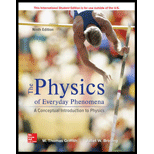
Concept explainers
When two different materials are rubbed together, do the two materials acquire the same type of charge or different types of charge? Explain how you could justify your answer with a simple experiment.
Whether two materials which are rubbed together acquire similar or opposite charge.
Answer to Problem 1CQ
The two materials which are rubbed together acquire opposite charges.
Explanation of Solution
Electric charge is a conserved quantity. When two materials are rubbed together, one material will lose electron and the other material will gain. So the total electric charge of the two materials remains same. The one which loses electron will become positively charged, while the one who accepts electron will become negatively charged. Thus two materials which are rubbed together acquire opposite charges.
As an example when a glass rod is rubbed in a silk cloth, the glass rod will acquire positive charge while the silk acquires negative charge.
Conclusion:
The two materials which are rubbed together acquire opposite charges.
Want to see more full solutions like this?
Chapter 12 Solutions
Physics of Everyday Phenomena
- The fundamental charge is e = 1.60 1019 C. Identify whether each of the following statements is true or false. (a) Its possible to transfer electric charge to an object so that its net electric charge is 7.5 times the fundamental electric charge, e. (b) All protons have a charge of +e. (c) Electrons in a conductor have a charge of e while electrons in an insulator have no charge.arrow_forwardThe fundamental charge is e = 1.60 1019 C. Identify whether each of the following statements is true or false. (a) Its possible to transfer electric charge to an object so that its net electric charge is 7.5 times the fundamental electric charge, e. (b) All protons have a charge of +e. (c) Electrons in a conductor have a charge of e while electrons in an insulator have no charge.arrow_forwardA person is placed in a large, hollow, metallic sphere that is insulated from ground, (a) If a large charge is placed on the sphere, will the person be harmed upon touching the inside of the sphere? (b) Explain what will happen if the person also has an initial charge whose sign is opposite that of the charge on the sphere.arrow_forward
- A very large, thin, flat plate of aluminum of area A has a total charge Q uniformly distributed over its surfaces. Assuming the same charge is spread uniformly over the upper surface of an otherwise identical glass plate, compare the electric fields just above the center of the upper surface of each plate.arrow_forwardAn eccentric inventor attempts to levitate by first placing a large negative charge on himself and then putting a large positive charge on the ceiling of his workshop. Instead, while attempting to place a large negative charge on himself, his clothes fly off. Explain.arrow_forwardReview. A light, unstressed spring has length d. Two identical particles, each with charge q, are connected to the opposite ends of the spring. The particles are held stationary a distance d apart and then released at the same moment. The system then oscillates on a frictionless, horizontal table. The spring has a bit of internal kinetic friction, so the oscillation is damped. The particles eventually stop vibrating when the distance between them is 3d. Assume the system of the spring and two charged particles is isolated. Find the increase in internal energy that appears in the spring during the oscillations.arrow_forward
- Why do most objects tend to contain nearly equal numbers of positive and negative charges?arrow_forwardUsing Figure 18.43, explain, in terms of Coulomb's law, why a polar molecule (such as in Figure 18.43) is attracted by both positive and negative charges Figure 18.43 Schematic representation of the outer electron cloud of a neutral water molecule. The electrons spend more time near the oxygen than the hydrogens, giving a permanent charge separation as shown. Water is thus a polar molecule. It is more easily affected by electrostatic forces thanarrow_forwardA water molecule consists of two hydrogen atoms bonded with one oxygen atom. The bond angle between the two hydrogen atoms is 104( (see below). Calculate the net dipole moment of a water molecule that is placed in a uniform, horizontal electric field of magnitude 2.3108N/C . (You are missing some information for solving this problem; you will need to determine what information you need, and look it up.)arrow_forward
- Review. A particle with a charge of 60.0 nC is placed at the center of a nonconducting spherical shell of inner radius 20.0 cm and outer radius 25.0 cm. The spherical shell carries charge with a uniform density of 1.33 C/m3. A proton moves in a circular orbit just outside the spherical shell. Calculate the speed of the proton.arrow_forwardWhy does a car always attract dust right after it is polished? (Note that car wax and car tires are insulators.)arrow_forwardTwo small, identical metal balls with charges 5.0 C and 15.0 C are held in place 1.0 m apart. In an experiment, they are connected for a short time by a conducting wire. a. What will be the charge on each ball after this experiment? b. By what factor will the magnitude of the electrostatic force on either ball change after this experiment is performed?arrow_forward
 Physics for Scientists and Engineers: Foundations...PhysicsISBN:9781133939146Author:Katz, Debora M.Publisher:Cengage Learning
Physics for Scientists and Engineers: Foundations...PhysicsISBN:9781133939146Author:Katz, Debora M.Publisher:Cengage Learning College PhysicsPhysicsISBN:9781285737027Author:Raymond A. Serway, Chris VuillePublisher:Cengage Learning
College PhysicsPhysicsISBN:9781285737027Author:Raymond A. Serway, Chris VuillePublisher:Cengage Learning College PhysicsPhysicsISBN:9781305952300Author:Raymond A. Serway, Chris VuillePublisher:Cengage Learning
College PhysicsPhysicsISBN:9781305952300Author:Raymond A. Serway, Chris VuillePublisher:Cengage Learning Physics for Scientists and Engineers, Technology ...PhysicsISBN:9781305116399Author:Raymond A. Serway, John W. JewettPublisher:Cengage Learning
Physics for Scientists and Engineers, Technology ...PhysicsISBN:9781305116399Author:Raymond A. Serway, John W. JewettPublisher:Cengage Learning Principles of Physics: A Calculus-Based TextPhysicsISBN:9781133104261Author:Raymond A. Serway, John W. JewettPublisher:Cengage Learning
Principles of Physics: A Calculus-Based TextPhysicsISBN:9781133104261Author:Raymond A. Serway, John W. JewettPublisher:Cengage Learning College PhysicsPhysicsISBN:9781938168000Author:Paul Peter Urone, Roger HinrichsPublisher:OpenStax College
College PhysicsPhysicsISBN:9781938168000Author:Paul Peter Urone, Roger HinrichsPublisher:OpenStax College





